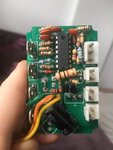necroshine83
Newbie level 4
Dear forum user,
I am new at this forum. I need some help about the electric scooter board which is as similar as i try to post here. The problem is, there is a fault scenario like that: when my child driving the e-scooter motor suddenly behave like full throttle. At this point, i can't make the e-scooter stop. The only solution is disassemble the battery pack or motor.
I tried some workarounds. I made 2 mosfets in parallel and attached them on to a copper laptop cooler. it survived a while but same issue happened.
The only difference my original circuit:
I dont have D1 diode and 2.4k resistor paralel to hall sensor.
My main capacitor is 220uF 50V
I have 1 mosfet irfz44, there was a burn resistor which i measured aroun 1/8 watt 1.46k between transistor out and mosfet in. I replaced them with 33 ohm 1/4 watt resistor. What does it do?
There is an extra 100k resistor between + of the comparator1 and ground.
I replaced 2 x12V acid battery with 25.2 lithium ion battery, so main voltage is 25.2 volt at full charge.
I am new at this forum. I need some help about the electric scooter board which is as similar as i try to post here. The problem is, there is a fault scenario like that: when my child driving the e-scooter motor suddenly behave like full throttle. At this point, i can't make the e-scooter stop. The only solution is disassemble the battery pack or motor.
I tried some workarounds. I made 2 mosfets in parallel and attached them on to a copper laptop cooler. it survived a while but same issue happened.
The only difference my original circuit:
I dont have D1 diode and 2.4k resistor paralel to hall sensor.
My main capacitor is 220uF 50V
I have 1 mosfet irfz44, there was a burn resistor which i measured aroun 1/8 watt 1.46k between transistor out and mosfet in. I replaced them with 33 ohm 1/4 watt resistor. What does it do?
There is an extra 100k resistor between + of the comparator1 and ground.
I replaced 2 x12V acid battery with 25.2 lithium ion battery, so main voltage is 25.2 volt at full charge.
Attachments
Last edited:

